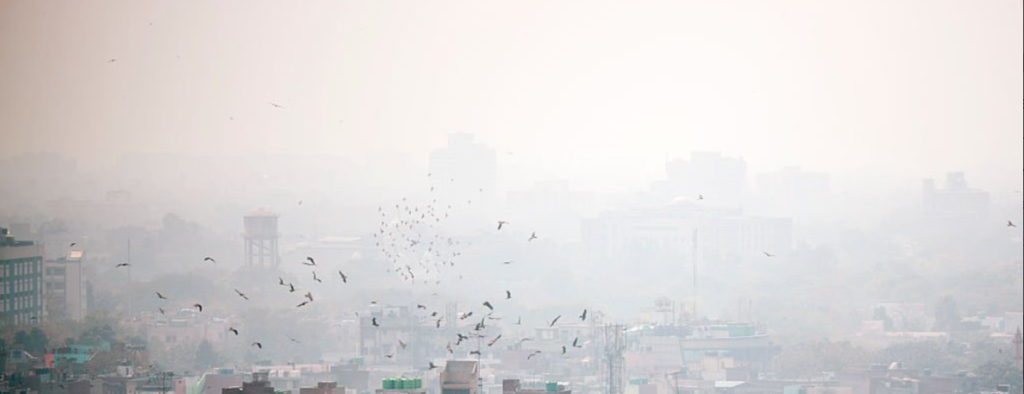With Diwali celebrations behind us, Delhi begins to experience the full onset of winter. The days gradually become shorter, and the air grows cooler, bringing a refreshing change after the long summer and monsoon seasons. But along with the drop in temperature comes a persistent challenge: declining air quality, often exacerbated by post-festival conditions. Let’s take a closer look at the weather, air quality concerns, and ways we can adapt and protect ourselves in the days following Diwali.

1. Cooler Temperatures Set In
- As the festive season concludes, Delhi’s weather sees a distinct shift. November marks the beginning of winter, with daytime temperatures typically ranging from 20-25°C, while night temperatures can dip to around 10-15°C. December and January will see these temperatures fall even further, with chilly mornings and cool evenings becoming the norm.
- The drop in temperature brings relief from the lingering heat, and many Delhi residents eagerly await the change to cooler weather. However, along with the temperature shift, the dense city air also becomes less conducive to dispersing pollutants, setting the stage for an ongoing struggle with air quality.
2. Air Quality Decline: Diwali’s Aftermath and Winter Conditions
- Diwali, known for its vibrant celebrations and fireworks, can unfortunately lead to a temporary spike in pollutants. The use of firecrackers increases the concentration of particulate matter (PM2.5 and PM10) in the air, creating a smoggy haze that can persist for days, depending on weather conditions.
- Adding to this is the onset of winter, which creates a phenomenon known as temperature inversion. During colder months, the air near the surface cools down faster than the air above, trapping pollutants close to the ground. This phenomenon contributes to an increase in smog levels, with PM2.5 levels often exceeding safe limits.
- Another significant contributor is the burning of crop stubble in neighboring states like Punjab and Haryana. Farmers set fire to leftover stubble in the fields to clear them for the next crop cycle, and these fires release large amounts of smoke and particulates that drift into Delhi, worsening the air quality.
3. Common Health Effects and Precautions
- The decline in air quality after Diwali often causes health issues, particularly among children, the elderly, and those with respiratory conditions. Many residents experience symptoms such as coughing, throat irritation, watery eyes, and shortness of breath.
- Wearing N95 masks when outdoors can help filter out some of the harmful particles. Additionally, investing in indoor air purifiers can provide cleaner air in homes, especially for individuals with asthma or other respiratory conditions. Staying hydrated and avoiding prolonged outdoor activities can also mitigate some effects of poor air quality.
4. Ways to Improve the Air Quality Post-Diwali
- Addressing air quality issues requires both individual and collective efforts. Some practical steps residents can take include:
- Limit Outdoor Fires: Avoid burning leaves or garbage, which releases harmful particles into the air. Instead, look for sustainable disposal methods.
- Use Public Transport: Reducing car emissions by using public transport, carpooling, or opting for electric vehicles can help minimize pollution.
- Indoor Plants: Some indoor plants, such as spider plants, peace lilies, and snake plants, help purify indoor air naturally by absorbing pollutants.
- Community Initiatives: Participate in or support community-led tree planting and awareness programs, which aim to improve greenery and reduce air pollution.
5. The Road Ahead: Striving for Cleaner Air
- While post-Diwali pollution is a reality that Delhi faces each year, awareness and small lifestyle changes can make a difference. Citizens and authorities alike must work toward a sustainable and proactive approach to tackling air pollution.
- Governments are implementing policies, such as the Graded Response Action Plan (GRAP), which enforces stricter measures based on pollution levels. Residents can support these initiatives by staying informed and contributing to the conversation about clean air.
In Conclusion
Delhi’s post-Diwali weather is marked by the excitement of winter approaching, but it also brings a reminder of the air quality challenges the city faces. By taking precautions and making conscious efforts to reduce pollution, Delhiites can enjoy a healthier, cleaner winter. The path to cleaner air may be long, but each step forward brings us closer to making it a reality.




